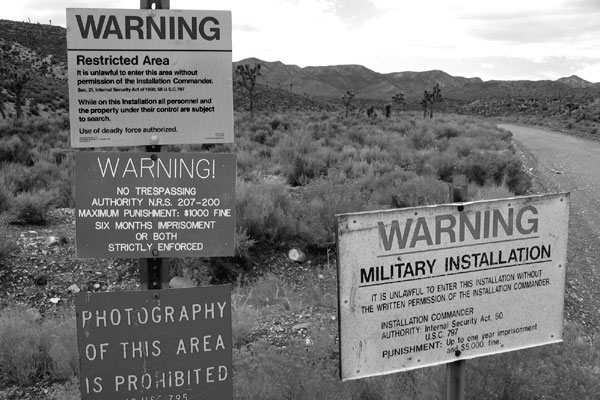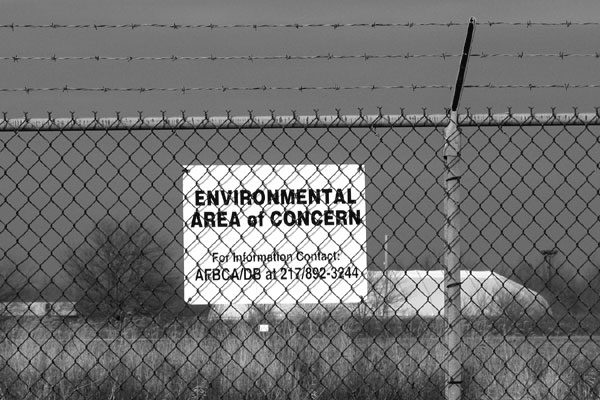HOME > SESSION II > TREVOR PAGLEN > March 10-11, 2005
Thursday / March 10
6-8pm > GOATSUCKER / EXPERIMENTAL LECTURE > Krannert Art Museum #62 / 500 E. Peabody Dr.
On March 20, 1998, rancher Jesse Gonzales made a startling discovery at his ranch near Arroyo Honda, New Mexico. One of his bulls was dead. But it was more than dead: its eyes were missing, its rectum cored, and its blood drained from the body. The previous evening, Gonzales had heard bizarre sounds and seen inexplicable lights coming from the desert skies.
For the last three decades, this scene has been repeated over and over throughout the Southwest. Some have explained the “cattle mutilation” phenomenon as the work of malevolent aliens, others claim that it is the work of the “black helicopters” of the New World Order, teenage satanic cults, or the infamous Chupacabras.
The vast majority of cattle mutilations occur in the vicinity of military operating areas, huge tracts of land (several the size of small countries) reserved for military activities: the Nellis Range, the White Sands Range, and many others. These places are home to secret squadrons of marauding “Goatsuckers,” “Screamin’ Demons,” and “Ghost Riders.”
The fatal effects of nuclear testing on humans and animals in the Southwest are well-known, but in the mid 1970s a new kind of death was being manufactured in hidden military enclaves. The programs, collectively known as “stealth,” have included some of the most highly-classified technologies since the bomb. And although “stealth” carried the promise of bringing invisible death to the state’s enemies, it, like the bomb before it, has brought invisible death to all life in its vicinity. From the clandestine production facilities in Burbank, California through the secret bases at Groom Lake and Tonopah, to simulated night raids on unsuspecting civilians, the legacy of stealth is a legacy of unseen environmental and social ruin. If stealth machines are not directly responsible for the wave of cattle mutilations since the mid 70s, there is nevertheless a weird resonance between these phenomena.
Presented as an experimental lecture in the form of an intelligence briefing, Goatsucker is a virtual tour through the killing fields of the stealth-fighter program.
Friday / March 11
10-11am > GUIDED TOUR @ Chanute Aerospace Museum / Location / Weather / Aerial Photograph
DRIVING DIRECTIONS TO CHANUTE FROM CHAMPAIGN >> Octave Chanute Aerospace Museum / 1011 Pacesetter Drive / Rantoul, IL 61866 / Tel: 217-893-1613
Chanute Aerospace Museum charges a fee of $6.00 for the guided tour (10-11am)
11am-1:30pm > CONVERSATION & WALK @ Chanute Aerospace Museum
Chanute AFB was constructed in 1917 and initially served as a pilot training facility and a storage depot for aircraft engines and paint. The base served as a training school for all Air Corps mechanics from 1922 to 1938. During World War II, technical training operations focused on aircraft maintenance and metal processing. Military flight operations were terminated at Chanute AFB in 1971, and base closure began in 1990 in response to an order issued by the Secretary of Defense. All military operations at the base ceased in September 1993, and portions of the base became available for commercial and other uses.
RESOURCES: Center for Land Use Interpretation / Land Use Database / Rantoul Township - Census 2000 Profile / Rantoul Village - Census 2000 Profile / EPA / IL EPA / Chanute AFB History / Village of Rantoul / Lincoln’s Challenge Academy / American Premium Foods Pork Packing Co-op
SECRET BASES > WALKING / TOURING / WITNESSING with TREVOR PAGLEN >
In defense-industry and aviation circles, people refer to the existence of two “worlds,” one of which they call the “white” world, and another called the “black” world.° The distinction between these two terms is that the “white” world involves unclassified research, development and spending. It is out the open. The “black” world, on the other hand, signifies all the work that is being done in secret.
It’s not an overstatement to describe the black world as a “world.” It is indeed a whole “world,” created by tens of billions of dollars in Pentagon spending on secret programs -- the exact number is, of course, classified, but current estimates put the figure at around 23.2 billion dollars for fiscal year 2003.
It’s a world with its own massive landscapes, its own corporations and privately-held firms, its own workers sworn to lifelong secrecy, its own engineers, pilots, accountants, mail deliverers, garbage collectors, and truck drivers. It is a landscape produced through secrecy, compartmentalization, and is largely immune from public oversight.
This project explores militarism and state secrecy through the fragmented images, sounds, histories, and documents that these restricted landscapes exude.
8-10pm > PRESENTATION @ MESSHALL-CHICAGO / Directions
Secret Bases Tour with Trevor Paglen > Global military superpowers need room to figure things out, in secret. Trevor Paglen talks about his travels to the outskirts of Area 51 and the Tonopah Test Range, two of the American government's biggest secret outdoor laboratories.
Mess Hall is an experimental cultural center located in a storefront in the Rogers Park neighborhood of Chicago. It's an open space for events, lectures, workshops, art, ideas, and exchange...
6932 North Glenwood Avenue / Chicago, IL 60626
Morse stop on the Redline // Email: messhall8(at)yahoo.com // Tel: 773-465-4033
Trevor Paglen is an artist, writer, and experimental geographer working out of the Department of Geography at the University of California, Berkeley. His work involves deliberately blurring the lines between social science, contemporary art, and a host of even more obscure disciplines, in order to construct unfamiliar, yet meticulously researched, ways to interpret the world around us.
His work has shown at the Chicago Museum of Contemporary Art (2003), U.C. San Diego (2004), the California College of the Arts (2002), and numerous other arts venues, universities, conferences, and public spaces. He is a contributing editor to the Journal of Aesthetics and Protest and develops tactical media projects with the prison-abolitionist group Critical Resistance. Paglen’s writing has been published in Blu Magazine, Art Journal, and will be included in the upcoming collection Inhuman Geographies/Spaces of Political Violence (Routledge).
Boom! Boom! Boom!
Sounds of drums echo off the horizon. Crickets strike a fleeting dissonant chord in their delicate overture to the decaying bodies slumbering under the moist earth. Train bells glow red and begin to ring... something shuffles through the tall grass. I lower my antenna and pack my equipment into a muddy satchel. Tick, tick, tick, tick...
I am a geographer, aesthetician, and low-intensity insurrectionist. Specializing in urban reconnaissance and aesthetic booby-traps, my work is an expedition into the seething rainforest of everyday space: a decodable, but delicate and frangible constellation of living and breathing processes. Here there be tygers. Excavating the unclean and profane materials of conceived and lived environments - the noises, smells, and refuse - my task is to uncover and disrupt hidden forces, specters, ideologies, and encampments. Research and data gathering enjoy an uncongealed relationship to covert action and cultural monkeywrenching.
As a serious social researcher, I am interested in proposing new and unlikely models with which to describe the spaces that we inhabit. As an aesthetic interventionist, my interferences of normative spatial practices create situations conducive to pedagogy, counterproduction, and fleeting subversion.
TACTICS WITHOUT TEARS / The Journal of Aesthetics and Protest / Aaron Gach & Trevor Paglen
Session II Poster: DOWNLOAD PDF
Sponsors: College of Fine & Applied Arts // Frances P Rohlen Visiting Artist Fund // Center for Advanced Study // Krannert Art Museum // Initiative on Aging // School of Art & Design // The Environmental Council // Department of Kinesiology // SORF // Illinois Program for Research in the Humanities // Robert Allerton Park // Unit for Criticism and Interpretive Theory // Native American House // Asian American Studies // Department of Anthropology // Landscape Architecture
Photo Credit: Trevor Paglen / Tonopah Test Range and Area 51 (TOP) // Nicholas Brown / Chanute AFB (BOTTOM)
Additional Information: Nicholas Brown / Kevin Hamilton
HOME & INTRODUCTION // SCHEDULE & PARTICIPANTS // BIBLIOGRAPHY & LINKS
WKM READING GROUP // ONLINE EXCHANGE // OTHER WALKERS
... A PROTRACTED SYMPOSIUM ...
WALKING AS KNOWING AS MAKING // A PERIPATETIC INVESTIGATION OF PLACE
SPRING 2005 // UNIVERSITY OF ILLINOIS @ URBANA-CHAMPAIGN |





